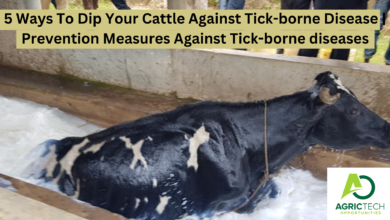Approved Method To Treat Bovine Mastitis In Dairy Cattle |Overview Of Mastitis| 2023/24

Host Country
GLOBAL
Target Audience
INTERNATIONAL (GLOBAL)
Program Overview
Mastitis is the inflammation of the udder happens when bacteria enters udder through teat canal. A painful infection of the breast tissue. It is measured indirectly by way of Somatic cell Counts (SCCs). Is the most important disease of economic importance in dairy cattle.
ALSO CHECK: Starting Your Own Dairy Enterprises And Becoming A Dairy Farmer In South Africa
How To Treat Bovine Mastitis In Dairy Cattle:
Types of causative agents
Most infections are due to various species of streptococci (or similar gram-positive cocci), staphylococci, and gram-negative rods, especially lactose-fermenting organisms of enteric origin, commonly termed coliforms
Primary reservoirs of infection are contagious or environmental.
Only Mycoplasma spp, may spread from cow to cow through aerosol transmission others (contagious) spread during milking
Overview of Mastitis
Mastitis is the most costly disease of all diseases in Cattle (NADIS, 2021). Economic costs vary by farm and depends on level of infection resulting in 40% to 60% loss in milk yield on average. A dairy cow produces at least 6 000L of milk per lactation if 40% (i.e. 6 000L) is lost, farmers loses 2 400L costing USD1 200. Not only in terms of milk yield, but cost of treatment, time management and sometimes loss of the animal through death.
Intramammary infections
Can be described as subclinical or clinical
Subclinical mastitis is the presence of an infection without apparent signs of local inflammation or systemic involvement. It is asymptomatic. If the infection persists for at least two months, the infection is termed chronic. Once established, many of these infections persist for entire lactations or the life of the cow.
Detection of subclinical mastitis is best done by testing milk for somatic cell counts (SCCs) using either the California Mastitis Test or automated methods. Inflammatory changes and decreases in milk quality may start with SCCs as low as 100,000 cells/mL. Herd SCCs <200,000 cells/mL are considered desirable, and lower counts can be attained.
ALSO READ: Approved Principles Of Poultry Production For 2023/24
Intramammary infections
Clinical mastitis is an inflammatory response to infection causing visibly abnormal milk (eg, color, fibrin clots). As inflammation increases, changes in the udder (swelling, heat, pain, redness) may also be apparent. If the inflammatory response includes systemic involvement (fever, anorexia, shock), the case is termed severe. Gangrenous mastitis can also occur, particularly when subclinical, chronic infections of S aureus become severe at times of immune dysfunction (eg, at parturition).
Possible causes are a blocked milk duct or bacteria entering the breast. It usually occurs within the first three months of breast-feeding.
Symptoms include breast pain, swelling, warmth, fever and chills.
Antibiotics are required. Mild pain relievers can help with discomfort.

Agents of mastitis
Etiological agents
Staphylococcus aureus
Escherichia coli
Streptococcus algalactiae
Streptococcus uberis
Streptococcus disgalatiae
Truepella pyrogenes
Arcanobacterium pyrogenes
ALSO READ: The Power of Networking And Connections To Succeed For Interns 2023/24
Management
•Antibiotics (synthetic)
•Bacteriophages
•Vaccination
•Nanoparticels
•Cytokines
•Animal derived antimicrobials
•Bacteria and Bacteria-Derived Antimicrobials
•Plant derived antimicrobials
The Best treatment of mastitis ( Antibiotics.)
There are two options: intramammary antibiotics, the classic mastitis tube and systemic antibiotics given by the intramuscular or subcutaneous route. Intramammary antibiotics should be the first-line treatment for cows with mild uncomplicated mastitis in a single quarter.
If you have an infection, a 10-day course of antibiotics is usually needed. It’s important to take all of the medication to minimize your chance of recurrence. If your mastitis doesn’t clear up after taking antibiotics, follow up with your vet.
ALSO READ: The Benefits of Doing an Internship: How It Can Help You Get Ahead in Your Career
For more updates On Agric Tech Opportunities kindly join the social groups below:
Join our Telegram | Follow us on Linkedin | Also, Follow us on Twitter. | Join Our Whatsapp Group
God bless and All the best !!

